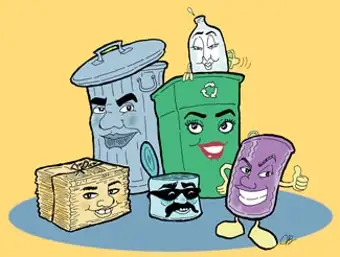RecyclaBuddies

Graphic Artist Carefully Assigns Ethnicities To Anthropomorphic Recyclables
8/27/03 3:00PM
PHILADELPHIA—Freelance graphic artist Chrissie Bellisle carefully delineated the ethnicities, genders, and sexual orientations of the RecyclaBuddies, a group of talking recyclables created for a public-service leaflet she submitted to the Department of Sanitation Monday.
“I assumed the Department of Sanitation would want the recyclables in its new leaflet to represent not only Philadelphia’s recycling procedures, but also its diverse ethnic make-up,” said Bellisle, flipping through some initial sketches in her studio. “It turned out to be quite a challenge.”
As the purpose behind establishing racial and cultural identities for the talking waste was one of celebration, not caricature, Bellisle found herself working within unusual limits.
“For reasons of basic sensitivity, you don’t want to make the Chinese take-out container an Asian,” Bellisle said, as she flipped past a crossed-out pencil sketch of an Inuit ice-cream carton. “But, if you make the same type of container represent two different races, people notice. It’s a delicate balancing act. I discovered that there were negative connotations attached to a surprising number of the things people throw out.”
Although she said she is satisfied with her decision to incorporate Asiatic epicanthic folds into the eyes of an age-discolored stack of newspapers, Bellisle admitted that infusing everyday household garbage with easily recognizable racial traits—while avoiding demeaning stereotypes—is difficult.
“It took me forever to get this trash can to look like a black guy, especially around the nose,” said Bellisle, who noted that she discarded close to 30 preliminary characters, among them a Native American milk carton, a Filipino cereal box, and a stack of East Indian wire-hangers. “I finally made the green recycling drum a woman, which was great, since a garbage can is kind of husky, and I could get around the sexy-garbage/body-image issue.”
Added Bellisle: “That brings another problem to light: If you include one woman in the mix, no one cares what race she is. As if one female recycling drum can represent female recycling drums of all races, but male recyclables deserve further distinction.”
Drawing friendly, nondescript male characters is not the answer, said Bellisle.
“Look at this grinning soda can giving the thumbs-up here,” she said. “Everyone subconsciously assumes it’s a Caucasian male.”
As of press time, Bellisle was still struggling with drawings for a RecyclaBuddies poster to complement the leaflet.
“I have no idea how to make the plastic milk jug look gay,” Bellisle said. “I don’t want to make him a bottle of water, for obvious reasons. Maybe I’ll use a soy-milk container when I draw the gay jug. Or maybe they’ll let me switch him with the Chicano, this tin can here. I wasn’t too pleased with the Chicano tin can to begin with, especially because my first instinct was to put tomatoes or beans on the can. Not because he’s Chicano, but because he’s a can.”
“And I’m really not looking forward to doing the page that explains the symbols on the bottom of plastic containers,” Bellisle added. “Who am I to determine which RecyclaBuddy of color is a 1 and which is a 5?”
Heather Franks, a public-relations official with Philadelphia’s Department of Sanitation, was quick to laud Bellisle’s efforts.
“We’re very pleased with Chrissie’s work on the RecyclaBuddies so far,” Franks said. “We haven’t given final approval to anything, but we’ve liked the range and depth of the sketches we’ve seen. They really provide a sense of the cultural diversity that exists in the Philadelphia trash-collection zone.”
Added Franks: “We especially love that soda can giving the thumbs-up. I don’t know what it is about that little guy, but we’re thinking of making him the boss of the whole crew.”